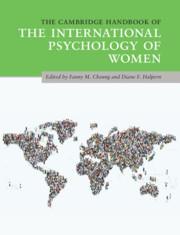Book contents
- The Cambridge Handbook of the International Psychology of Women
- The Cambridge Handbook of the International Psychology of Women
- Copyright page
- Dedication
- Contents
- Figures
- Tables
- Contributors
- Acknowledgments
- Section 1 The Underpinnings of Sex and Gender and How to Study Them
- Section 2 Developmental Perspectives of the International Psychology of Women
- Section 3 Cognitive and Social Factors
- 10 Sex, Gender, and Intelligence
- 11 At the Crossroads of Women’s Experience
- 12 Gender and Personality Research in Psychology
- 13 Selfhood and Self-Construal
- 14 Cultural Influences on Body Image and Body Esteem
- 15 The Not So Subtle and Status Quo Maintaining Nature of Everyday Sexism
- 16 A Gendered Light on Empathy, Prosocial Behavior, and Forgiveness
- 17 The Impact of Gender and Culture in Consumer Behavior
- 18 Evolutionary Roots of Women’s Aggression
- Section 4 Work and Family Issues
- Section 5 Inequality and Social Justice
- Section 6 Health and Well-Being
- Epilogue Some Final Thoughts and Take-Home Messages
- Index
- References
18 - Evolutionary Roots of Women’s Aggression
Causes, Contexts, and Consequences
from Section 3 - Cognitive and Social Factors
Published online by Cambridge University Press: 20 July 2020
- The Cambridge Handbook of the International Psychology of Women
- The Cambridge Handbook of the International Psychology of Women
- Copyright page
- Dedication
- Contents
- Figures
- Tables
- Contributors
- Acknowledgments
- Section 1 The Underpinnings of Sex and Gender and How to Study Them
- Section 2 Developmental Perspectives of the International Psychology of Women
- Section 3 Cognitive and Social Factors
- 10 Sex, Gender, and Intelligence
- 11 At the Crossroads of Women’s Experience
- 12 Gender and Personality Research in Psychology
- 13 Selfhood and Self-Construal
- 14 Cultural Influences on Body Image and Body Esteem
- 15 The Not So Subtle and Status Quo Maintaining Nature of Everyday Sexism
- 16 A Gendered Light on Empathy, Prosocial Behavior, and Forgiveness
- 17 The Impact of Gender and Culture in Consumer Behavior
- 18 Evolutionary Roots of Women’s Aggression
- Section 4 Work and Family Issues
- Section 5 Inequality and Social Justice
- Section 6 Health and Well-Being
- Epilogue Some Final Thoughts and Take-Home Messages
- Index
- References
Summary
From an evolutionary perspective, aggression is viewed as a flexible context-specific adaption that was selected for because it enhanced the survival and reproductive success of ancestral humans. Evolutionary pressures have impinged differentially on the sexes, leading to the hypothesis that sex differences should be manifest in aggressive behavior. Evidence to date supports key predictions made from sexual selection theory that women direct their aggression primarily toward same-sex competitors, which peaks as mate competition intensifies. Women demonstrate a notable preference across cultures for more indirect, as opposed to direct, forms of intrasexual rivalry as a likely consequence of heightened obligatory parental investment, lower lifetime reproductive potential, and the greater importance of maternal survival for the health and longevity of offspring. An evolutionary approach can yield unique insights into the sex-differentiated functions, development, and outcomes of aggressive behavior.
Keywords
- Type
- Chapter
- Information
- The Cambridge Handbook of the International Psychology of Women , pp. 258 - 272Publisher: Cambridge University PressPrint publication year: 2020
References
Suggested Readings

Adam Davis is currently enrolled in a PhD program in Education at the University of Ottawa. His principal research interests involve using an evolutionary perspective, particularly sexual selection theory, to study dark personality traits, jealousy, and aggressive behavior among adolescents and young adults. His secondary program of research is focused around studying the links between cognitive styles, environmental values, and pro-environmental behavior. Davis was born in Ontario, Canada where he has lived his entire life. He has spent two weeks in Honduras during graduate school helping graduate students with behavioral ecology research on howler monkeys. He identifies himself as atheist, democratic socialist, and feminist.

Tracy Vaillancourt is a Tier 1 Canada Research Chair in School-Based Mental Health and Violence Prevention at the University of Ottawa where she is cross-appointed as a Full Professor in Counselling Psychology and the School of Psychology. She is also an elected member of the College of the Royal Society of Canada. She received her BA, MA, and PhD from the University of British Columbia (human development), her postdoctoral diploma from the University of Montreal and Laval University (developmental psychology), and postdoctoral respecialization in applied child psychology (clinical) from McGill University. Vaillancourt’s research examines the links between bullying and mental health, with a particular focus on social neuroscience. She is currently funded by the Canadian Institutes of Health Research and the Social Sciences and Humanities Council of Canada.

John Archer is an Emeritus Professor at the University of Central Lancashire, Preston. He has been an active researcher in the field of aggressive behavior for more than 40 years, focusing his research on aggression and violence and, in particular, sex differences in aggression, including in relation to sexual selection, partner violence, the relations between testosterone and aggression, and resource holding power and aggression. Archer served as the editor-in-chief of Aggressive Behavior from 2012 to 2018. He was recipient of the John Paul Scott Award from the International Society for Research on Aggression (ISRA) in 2016, and was made a Life Fellow of ISRA in 2018 “in recognition of his distinguished lifetime contribution to research on aggression.” Born in Windsor, UK, he went to University College of Wales, Aberystwyth, for his undergraduate degree and University of Bristol for his PhD.



